
Chapter 21: Plant Responses and Reproduction
21.1 Plant Hormones
Animals respond to environmental stimuli by moving toward or away from the stimulus.
Plants respond to environmental stimuli by growing toward or away from the stimulus.
Growth responses in plants occur at the cellular level and are mediated by hormones.
Plant hormones are small, organic molecules produced by a plant that serve as chemical signals between cells and tissues.
Hormones bind to receptor proteins and signal the cell to respond to the stimulus.
The five commonly recognized groups of plant hormones are auxins, gibberellins, cytokinins, abscisic acid, and ethylene (Table 21.1).
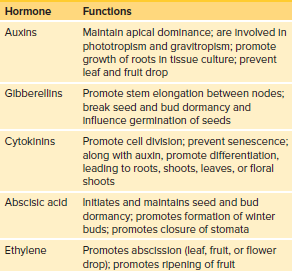

Auxins
Auxin is an organic substance that was the first plant hormone to be discovered over a century ago.
Auxin softens the cell wall of plant cells to allow for growth.
Auxin is involved in phototropism, which causes the bending of the stem towards a light source.
The elongation of cells in the shade occurs due to a series of events, including auxin binding to a protein receptor, active pumping of hydrogen ions out of the cell, the creation of an acidic environment, and the softening of the cell wall.
Auxin is responsible for apical dominance, which inhibits the growth of lateral buds in plants.
Synthetic auxins are used in various applications, such as inducing fruit development without pollination and controlling broadleaf weeds. Agent Orange is a powerful synthetic auxin that was used as a defoliant during the Vietnam War and was found to be carcinogenic.
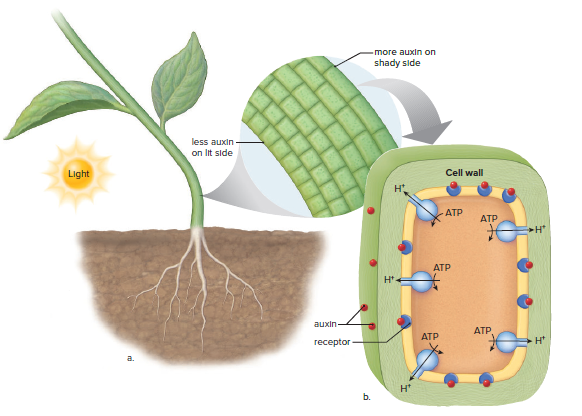
Gibberellins
Gibberellins were discovered in 1926 by a Japanese scientist investigating a fungal disease of rice plants called "foolish seedling disease."
The fungus infecting the plants produced an excess of a chemical called gibberellin, named after the fungus, Gibberella fujikuroi.
In 1956, a form of gibberellin known as gibberellic acid was isolated from a flowering plant.
Over 130 different gibberellins have been identified, with gibberellic acid (GA3) being the most common.
Natural gibberellins can be found in young leaves, roots, embryos, seeds, and fruits.
Gibberellins are growth-promoting hormones that bring about elongation of cells.
When applied externally to plants, gibberellins cause stem elongation between the nodes.
Gibberellins have many commercial uses, including promoting growth in crops such as apples, cherries, and sugarcane.
GA3 is used on table grapes to increase fruit stem length and size.
Gibberellins are used in the brewing industry to break the dormancy of barley grains, yielding fermentable sugars for ethanol production.
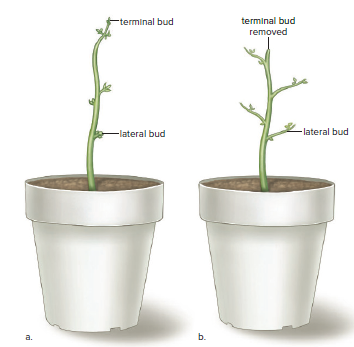
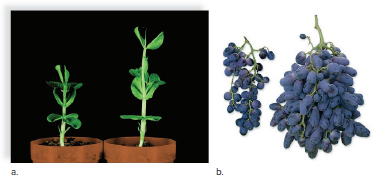
Cytokinins
Cytokinins were discovered in the 1940s during attempts to grow plant tissues and organs in culture vessels.
Cell division occurs when coconut milk and yeast extract are added to the culture medium.
The effective agents could not be isolated at the time, so they were collectively called cytokinins.
A naturally occurring cytokinin called zeatin was not isolated until 1967 from maize kernels.
Cytokinins promote cell division and prevent the senescence of plant organs.
Cytokinins are found in plant meristems, young leaves, root tips, seeds, and fruits.
The ratio of auxin to cytokinin and the acidity of the culture medium determines whether a plant tissue forms an undifferentiated mass or differentiates to form roots, vegetative shoots, leaves, or floral shoots.
The presence of auxin and cytokinins in certain ratios leads to the activation of an enzymatic pathway that influences the specialization of plant cells.
Abscisic Acid
A plant needs to protect itself if environmental conditions are not favorable.
Abscisic acid initiates and maintains seed and bud dormancy and causes the closure of stomata.
Dormancy begins when a plant stops growing and prepares for adverse conditions.
Abscisic acid moves from leaves to vegetative buds in the fall, converting them to winter buds.
Winter buds are covered by thick, hardened scales.
A reduction in abscisic acid and an increase in gibberellins break seed and bud dormancy.
Abscisic acid causes the closing of stomata when a plant is under water stress.
Abscisic acid causes potassium ions to leave guard cells, leading to the closing of stomata.
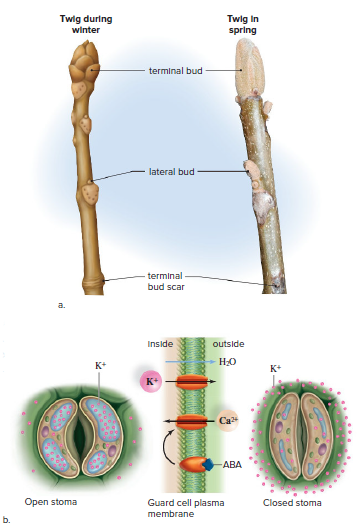
Ethylene
Abscisic acid was once believed to function in the process of abscission, which is the dropping of leaves, fruits, or flowers from a plant.
External application of abscisic acid promotes abscission, but it is no longer believed to function naturally in this process.
Ethylene is responsible for fruit abscission and fruit ripening in plants.
Ethylene is a gas that can move freely in the air and stimulates certain enzymes, such as cellulase, that cause leaf, fruit, or flower drop.
Cellulase hydrolyzes cellulose in plant cell walls and weakens that part of the plant.
Ethylene is often used commercially to ripen fruit just before it is delivered to the grocery store.
A barrel of ripening apples can induce ripening in a bunch of bananas, even if they are in different containers.
If a plant is wounded due to physical damage or infection, ethylene is released at the wound site.
One rotten apple spoils the whole barrel because it releases ethylene at the wound site.
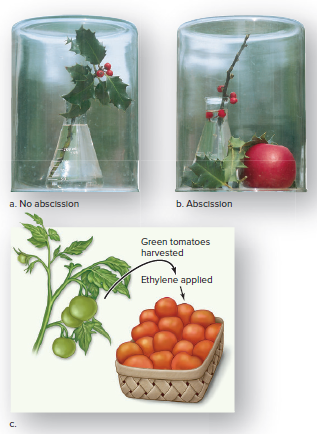
21.2 Plant Responses
Environmental stimuli such as light, day length, gravity, and touch strongly influence plant responses.
A plant's ability to respond to environmental signals enhances its survival in that environment.
Plant responses to environmental signals can be rapid or take some time.
Plant responses are most often exhibited in growth and sometimes changes in plant tissues.
Certain hormones play a role in bringing about these changes.
Tropisms
A plant's growth response towards or away from a directional stimulus is called a tropism.
Differential growth causes one side of an organ to elongate faster than the other, resulting in a curving towards or away from the stimulus.
Growth towards a stimulus is called a positive tropism, and growth away from a stimulus is called a negative tropism.
Phototropism is the growth of plants towards a source of light.
Gravitropism is the growth response of plants to Earth's gravity.
Thigmotropism is a response to touch from another plant, an animal, rocks, or the wind.
Phototropism, gravitropism, and thigmotropism were each named for the stimulus that causes the response.
Climbing vines such as English ivy use touch contact with rocks, tree trunks, or other supports for growth.
Root cells know which way is down because of the presence of an organelle called an amyloplast.

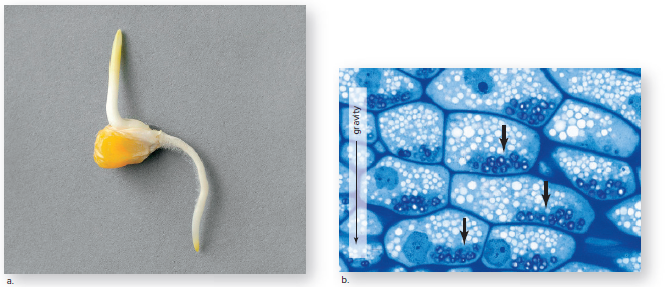
Photoperiodism
Flowering in angiosperms is a striking response to environmental, seasonal changes.
The length of day and night, or photoperiod, is a major factor that triggers flowering.
There are two types of flowering plants: long-day plants and short-day plants.
Long-day plants flower when the days are longer than a critical length.
Short-day plants flower when the days are shorter than a critical length.
The length of continuous darkness, not light, is what actually controls flowering in many plants.
Nurseries use this knowledge to make all types of flowers available throughout the year.
A pigment called phytochrome is involved in the detection of photoperiods.
Phytochrome can distinguish between red and far-red wavelengths of light.
The amount of far-red light relative to red light affects the growth of plants.
Plants that are close together perceive more far-red light and are more likely to grow tall.
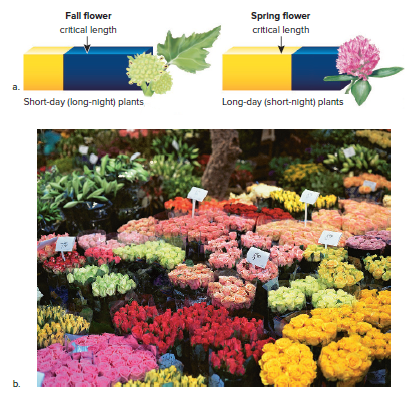
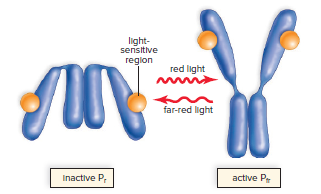
21.3 Sexual Reproduction in Flowering Plants
The plant life cycle has two multicellular stages that alternate.
This is called the alternation of generations.
Diploid (2n) sporophyte alternates with haploid (n) gametophyte.
Sporophyte (2n) produces haploid spores by meiosis.
Spores develop into gametophytes.
Gametophytes (n) produce gametes.
Upon fertilization, the cycle returns to 2n sporophyte.
Overview of the Plant Life Cycle
Flowering plants have an alternation-of-generations life cycle with modifications shown in Figure 21.11.
The sporophyte is dominant and produces flowers, which are the reproductive organs of angiosperms.
The flower produces two types of spores: microspores and megaspores.
Microspores develop into male gametophytes (pollen grains), and megaspores develop into female gametophytes (embryo sacs).
A pollen grain contains two nonflagellated sperm and is carried by wind or animals to the vicinity of the embryo sac.
The sperm move down the pollen tube to the embryo sac and fertilize the egg.
The zygote becomes an embryo, which develops into a seed with stored food and a seed coat.
The seeds are often enclosed by a fruit, which aids in dispersing the seeds.
When a seed germinates, a new sporophyte emerges and develops.
The life cycle of flowering plants is well adapted to a land existence and does not require external water for the transportation of pollen or sperm.
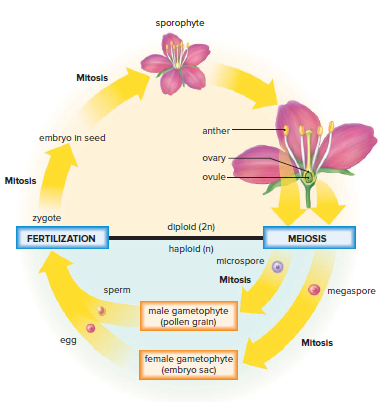
Flowers
The flower is a reproductive structure unique to angiosperms.
Flowers produce spores and protect gametophytes.
Flowers attract pollinators to transport pollen from plant to plant.
Flowers produce fruits that enclose seeds.
Angiosperms' success is largely due to the evolution of the flower.
In monocots, flower parts occur in threes and multiples of three; in eudicots, flower parts are in fours or fives and multiples of four or five.
A typical flower has four whorls of modified leaves attached to a receptacle at the end of a flower stalk.
Sepals protect the bud as the flower develops.
Petals are attractive to specific pollinators and account for the attractiveness of many flowers.
Stamens are the "male" portion of the flower and have two parts: the anther and the filament.
The carpel is the "female" portion of the flower and has three parts: the stigma, the style, and the ovary.
A flower can have a single carpel or multiple carpels.
Not all flowers have sepals, petals, stamens, and a carpel.
Flowers that have both stamens and carpels are called bisexual flowers.
Those with only stamens are male flowers, and those with only carpels are female flowers.
If both male and female flowers are on one plant, the plant is called monoecious.
If male and female flowers occur on separate plants, the plant is called dioecious.
Holly trees are dioecious, and it is necessary to acquire a plant with male flowers and another plant with female flowers to get red berries.
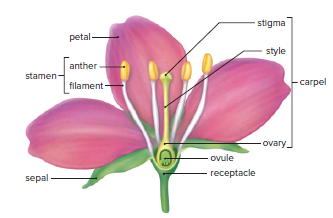
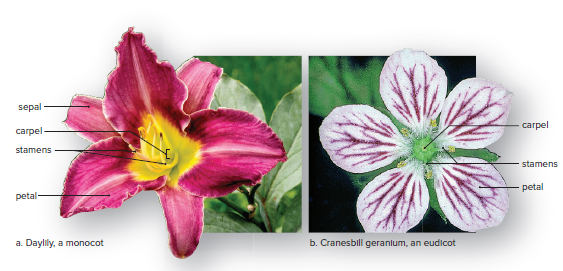
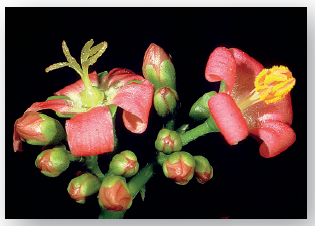
From Spores to Fertilization
The sporophyte of seed plants produces two types of spores: microspores and megaspores.
Microspores develop into male gametophytes or mature pollen grains.
Megaspores develop into the female gametophyte or embryo sac.
Microspores develop into pollen grains in the anthers of stamens.
A pollen grain consists of two cells, the larger cell produces a pollen tube, and the smaller cell divides to become two sperm.
The stamen is called the "male" portion of the flower.
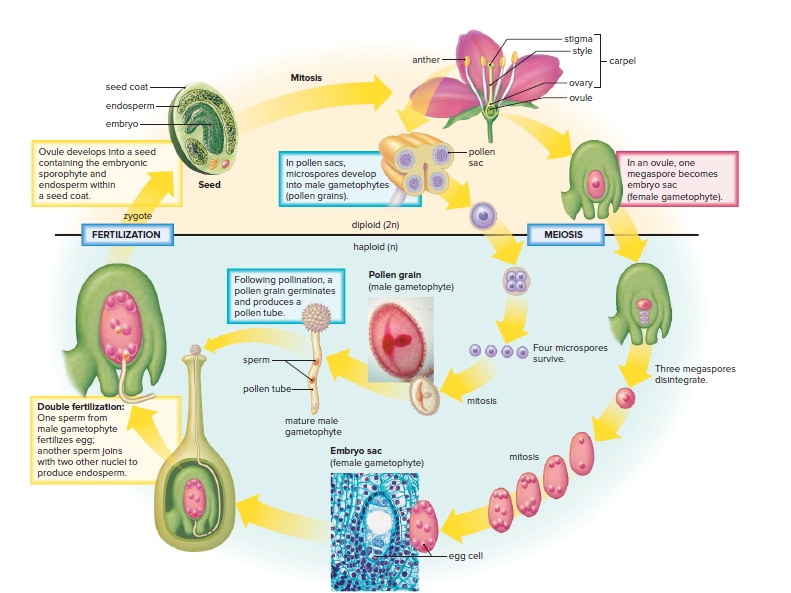
Pollen grains are unique to each plant and are transferred from the anther to the stigma of a carpel during pollination.
Cross-pollination is favored by adaptations in plants, such as staggered maturation of carpels and anthers or the assistance of animal pollinators.
Nectar secretion attracts insects, which inadvertently pick up poll en and transfer it to other plants of the same type.
Some plants have evolved to attract specific pollinators, such as carrion flowers that smell like rotting flesh to attract flies.
Megaspores develop within the ovule of a carpel, with one cell developing into the female gametophyte or embryo sac.
Fertilization occurs when a pollen grain lands on the stigma and develops a pollen tube, which contains two sperm.
Double fertilization occurs when one sperm unites with the egg to form a 2n zygote, and the other sperm unites with two nuclei to form a 3n endosperm cell.

Development of the Seed in a Eudicot
A seed has three parts: seed coat, embryo, and endosperm.
The seed coat is a protective covering that was once the ovule wall.
Double fertilization results in an endosperm nucleus and a zygote.
Cell division produces a multicellular embryo and a multicellular endosperm.
The endosperm is the stored food of a seed.
Figure 21.17 shows the stages in the development of the seed.
Eventually, a shoot and root tip containing apical meristems develop.
The cotyledons absorb the developing endosperm and become large and fleshy.
The food stored by the cotyledons will nourish the embryo when it resumes growth.
Cotyledons wither when the first true leaves grow and become functional.
The common garden bean is a eudicot seed with large cotyledons and no endosperm.
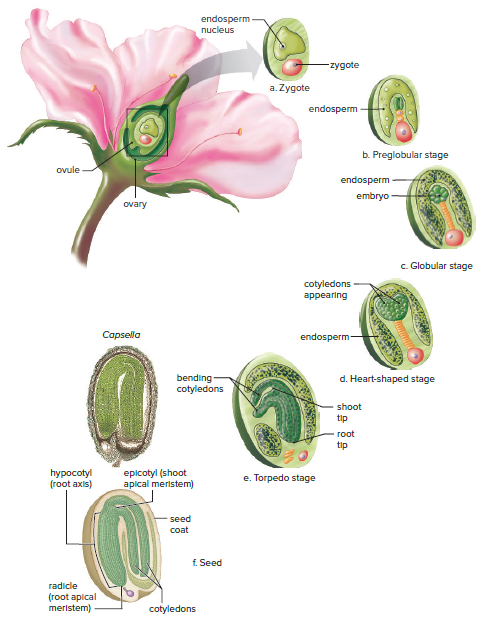
Monocots Versus Eudicots
Eudicot embryos have two cotyledons, while monocot embryos have only one cotyledon.
In monocots, the cotyledon stores and absorbs food molecules from the endosperm and passes them to the embryo.
The endosperm is retained in monocot seeds.
In eudicots, the cotyledons usually store all the nutrient molecules the embryo uses, and the endosperm disappears.
A corn plant is a monocot, so it has only one cotyledon, and the endosperm is present in the corn kernel.
Fruit Types and Seed Dispersal
Flowering plants have seeds enclosed by a fruit.
Seeds develop from ovules, and fruits develop from ovaries and sometimes other parts of a flower.
Market produce such as cucumber, tomatoes, and sugar snap peas are fruits because they contain seeds.
A vegetable is an edible plant part without seeds, such as celery, lettuce, and carrots.
Dry fruits are generally a dull color with a thin, dry ovary wall.
Grains such as wheat, corn, and rice have fruits that look like seeds.
Nuts have a hard outer shell covering a single seed.
Legumes have a several-seeded fruit that splits open to release the seeds.
Fleshy fruits have a juicy portion that is sometimes brightly colored to attract animals.
A drupe is a "stone fruit" with an outer fleshy part and an inner stony layer containing the seed.
A berry contains many seeds.
An apple is a pome, in which a dry ovary covers the seeds, and the fleshy part is derived from the receptacle of the flower.
A strawberry's flesh is derived from the receptacle, and what appear to be the seeds are actually dry fruits.

Dispersal of Seeds
Successful plants need to disperse their seeds long distances from the parent plant.
Seed dispersal methods include:
Birds and mammals eating fruits with seeds, which pass out of the digestive tract with the feces.
Squirrels and other animals gathering seeds and fruits, which they bury some distance away.
Hooks and spines of clover, cocklebur, and burdock fruits attach to the fur of animals and the clothing of humans.
Woolly hairs, plumes, and wings are adaptations for wind dispersal.
The dandelion fruit is attached to several hairs that function as a parachute and aid dispersal.
The winged fruit of a maple tree, which contains two seeds, can travel up to 10 kilometers from its parent.
Seed pods of a touch-me-not plant swell as they mature and burst when touched by a passing animal, hurling the ripe seeds some distance away from the plant.
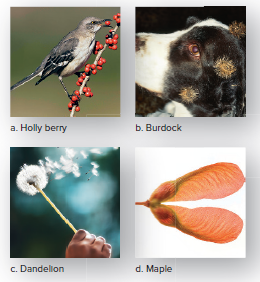
Germination of Seeds
Seeds germinate to form seedlings after dispersal.
Germination requires sufficient water, warmth, and oxygen.
In deserts, germination occurs only when there is adequate moisture.
Dormancy is the period when no growth occurs, even if conditions are favorable.
Some seeds require a period of dormancy before germination.
In the temperate zone, seeds often require exposure to cold weather to break dormancy.
Fleshy fruits contain inhibitors that prevent germination until the seeds are removed and washed.
Bacterial action and fire can make the seed coat permeable to water.
The uptake of water causes the seed coat to burst and germination to occur.
Eudicot Versus Monocot Germination
Bean Seed:
When cotyledons are parted, immature plants with leaves can be seen.
The shoot is hook-shaped to protect immature leaves as they grow.
Cotyledons shrivel up as true leaves begin photosynthesizing.
Corn Kernel:
Fruit of monocot with combined fruit and seed coat.
Single cotyledon inside.
Immature leaves and root covered by sheaths.
Sheaths are discarded when the seedling begins growing, and immature leaves become the first true leaves of the corn plant.
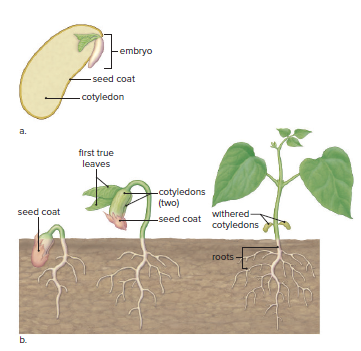
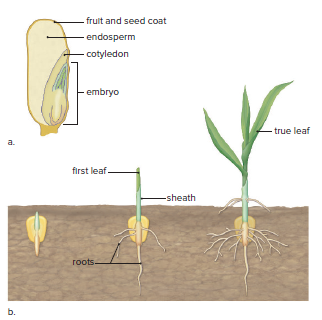
21.4 Asexual Reproduction and Genetic Engineering in Plants
Asexual reproduction involves only one parent.
All offspring produced through asexual reproduction are genetically identical to the parent.
Clones are preferred by plant sellers as they will have the same appearance and behavior as the parent plant.
Propagation of Plants in a Garden
Plants need to disperse their seeds to be successful in their environments.
There are various methods of seed dispersal, including animal consumption and transportation, wind dispersal, and bursting seed pods.
To create a bed of tulips, irises, or gladiolas, bulbs, rhizomes, or corms are used instead of seeds.
Baking potatoes are modified stems called tubers, and each “eye” has a bud that can become a new plant.
Fleshy, underground food-storage tissues contain buds that will sprout in the spring.
Runners, or stolons, such as those found in strawberries, are horizontal stems that can also result in new clonal plants.
Propagation of Plants in Tissue Culture
Asexual propagation techniques propagate pathogens along with the plant.
Plant pathogens can be viruses, bacteria, or fungi.
Clones created from an infected parent will also be infected.
Plants can be maintained in a disease-free status if clones from an uninfected parent are made in sterile test tubes through tissue culture.
Tissue culture is plant propagation done in a laboratory under sterile conditions.
One plant cell can grow an entirely new plant due to totipotency.
Techniques for tissue culture begin with cells from the meristem of the parent plant.
Meristematic cells are grown in a sterile, jellylike substrate in flasks, tubes, or Petri dishes.
The substrate contains growth hormones, vitamins, and macro- and micronutrients.
A mass of undifferentiated cells called a callus forms initially.
The addition of more nutrients and hormones will initiate organ formation until a fully developed plantlet is formed.
Tissue culture is important for propagating many fruits and vegetables found in local supermarkets.
Tissue culture is a more efficient means of producing disease-free male asparagus for growers.
Tissue culture is used for plant conservation and to increase populations of rare species in the wild.
Cell suspension culture is used to extract substances produced by plants.
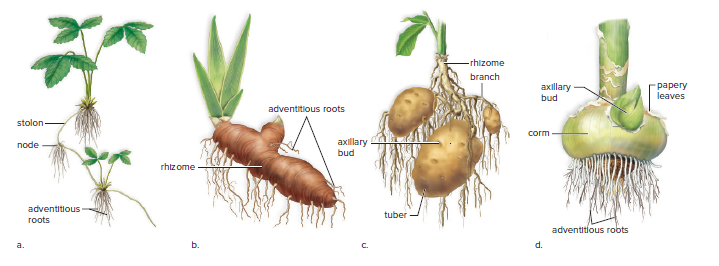
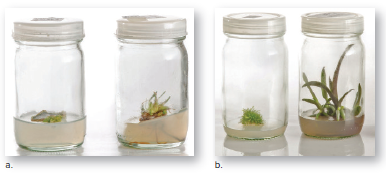
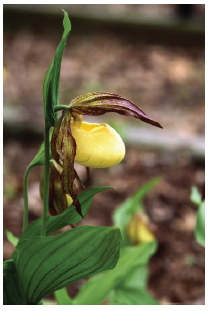
Genetic Engineering of Plants
Humans settled down to farm at least 10,000 years ago.
Plants were selected and hybridized to obtain desirable crops.
Hybridization is the crossing of different varieties of plants to produce plants with desirable traits.
Farming in this manner was suitable for feeding small communities of people.
Genetic engineering is used today to modify plants for food and textiles.
Large-scale DNA sequencing and advances in modern molecular genetics have increased the understanding of how genes work and how they can be incorporated into plant DNA for very precise additions of desirable traits.
A plant that has had its DNA altered in some way is said to be transgenic or genetically modified (GM).
GM plants are often modified with genes that improve agricultural, food quality, and medicinal traits.
Two ways genetic engineering is accomplished are through Agrobacterium tumefaciens and a particle gun that shoots DNA into plant cells for transformation.
Bt corn is a notable GM plant that is resistant to corn borers.
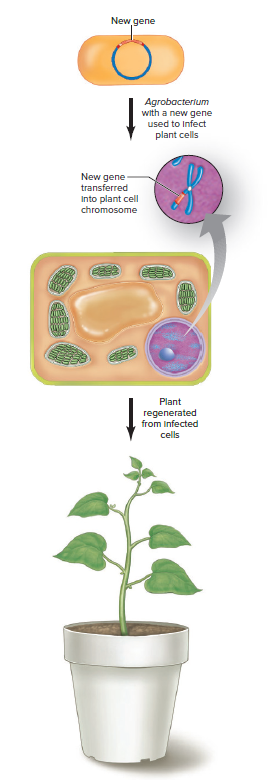
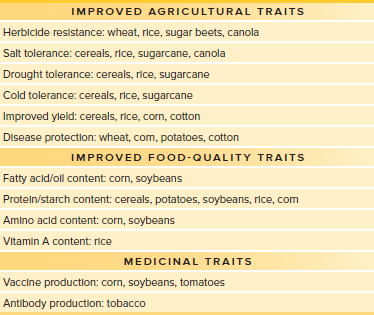
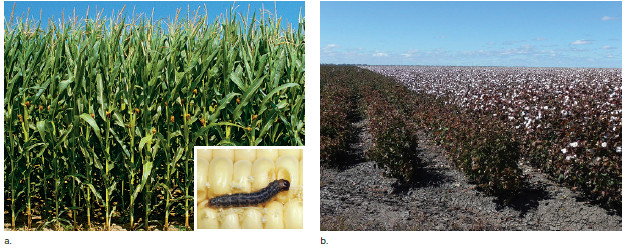
65% of the total U.S. corn crop is Bt corn.
Bt potato and Bt cotton also have this gene.
Golden rice has been genetically modified with daffodil and bacterial genes to produce beta-carotene.
Vitamin A deficiency affects between 140 and 250 million preschool children worldwide.
Provitamin A in the diet can be converted by enzymes in the body to vitamin A, alleviating the deficiency.
Environmental concerns about GM plants include possible cross-hybridization with wild plants, the possibility of creating herbicide-resistant "super weeds," and the effects of GM pollen on pollinators.
The biggest social concern is about the human and livestock consumption of GM plants.
Laws have been proposed to place labels on all foods made with GM crops.
New GM crops under development must undergo rigorous analysis and testing before being approved in the United States.
The American Association for the Advancement of Science (AAAS) released a statement in 2012 stating that genetic engineering resulting in crop improvement is safe and that food labeling would only falsely alarm consumers.
Pharmaceutical Products
Genetic engineering has led to research on plant-made pharmaceuticals.
Plants can produce antigens, antibodies, hormones, and therapeutic proteins.
Using plants to produce pharmaceuticals has advantages such as decreased cost, increased protein production, and decreased risk of contamination.
Tobacco plants are being used to develop an antibody to combat tooth decay.
A plant-made antibody against certain forms of lymphoma is being developed for humans.
Plants can also produce "hard-to-make" proteins such as anticoagulants, growth hormones, blood substitutes, collagen replacements, and antimicrobial agents.
Chapter 21: Plant Responses and Reproduction
21.1 Plant Hormones
Animals respond to environmental stimuli by moving toward or away from the stimulus.
Plants respond to environmental stimuli by growing toward or away from the stimulus.
Growth responses in plants occur at the cellular level and are mediated by hormones.
Plant hormones are small, organic molecules produced by a plant that serve as chemical signals between cells and tissues.
Hormones bind to receptor proteins and signal the cell to respond to the stimulus.
The five commonly recognized groups of plant hormones are auxins, gibberellins, cytokinins, abscisic acid, and ethylene (Table 21.1).


Auxins
Auxin is an organic substance that was the first plant hormone to be discovered over a century ago.
Auxin softens the cell wall of plant cells to allow for growth.
Auxin is involved in phototropism, which causes the bending of the stem towards a light source.
The elongation of cells in the shade occurs due to a series of events, including auxin binding to a protein receptor, active pumping of hydrogen ions out of the cell, the creation of an acidic environment, and the softening of the cell wall.
Auxin is responsible for apical dominance, which inhibits the growth of lateral buds in plants.
Synthetic auxins are used in various applications, such as inducing fruit development without pollination and controlling broadleaf weeds. Agent Orange is a powerful synthetic auxin that was used as a defoliant during the Vietnam War and was found to be carcinogenic.

Gibberellins
Gibberellins were discovered in 1926 by a Japanese scientist investigating a fungal disease of rice plants called "foolish seedling disease."
The fungus infecting the plants produced an excess of a chemical called gibberellin, named after the fungus, Gibberella fujikuroi.
In 1956, a form of gibberellin known as gibberellic acid was isolated from a flowering plant.
Over 130 different gibberellins have been identified, with gibberellic acid (GA3) being the most common.
Natural gibberellins can be found in young leaves, roots, embryos, seeds, and fruits.
Gibberellins are growth-promoting hormones that bring about elongation of cells.
When applied externally to plants, gibberellins cause stem elongation between the nodes.
Gibberellins have many commercial uses, including promoting growth in crops such as apples, cherries, and sugarcane.
GA3 is used on table grapes to increase fruit stem length and size.
Gibberellins are used in the brewing industry to break the dormancy of barley grains, yielding fermentable sugars for ethanol production.


Cytokinins
Cytokinins were discovered in the 1940s during attempts to grow plant tissues and organs in culture vessels.
Cell division occurs when coconut milk and yeast extract are added to the culture medium.
The effective agents could not be isolated at the time, so they were collectively called cytokinins.
A naturally occurring cytokinin called zeatin was not isolated until 1967 from maize kernels.
Cytokinins promote cell division and prevent the senescence of plant organs.
Cytokinins are found in plant meristems, young leaves, root tips, seeds, and fruits.
The ratio of auxin to cytokinin and the acidity of the culture medium determines whether a plant tissue forms an undifferentiated mass or differentiates to form roots, vegetative shoots, leaves, or floral shoots.
The presence of auxin and cytokinins in certain ratios leads to the activation of an enzymatic pathway that influences the specialization of plant cells.
Abscisic Acid
A plant needs to protect itself if environmental conditions are not favorable.
Abscisic acid initiates and maintains seed and bud dormancy and causes the closure of stomata.
Dormancy begins when a plant stops growing and prepares for adverse conditions.
Abscisic acid moves from leaves to vegetative buds in the fall, converting them to winter buds.
Winter buds are covered by thick, hardened scales.
A reduction in abscisic acid and an increase in gibberellins break seed and bud dormancy.
Abscisic acid causes the closing of stomata when a plant is under water stress.
Abscisic acid causes potassium ions to leave guard cells, leading to the closing of stomata.

Ethylene
Abscisic acid was once believed to function in the process of abscission, which is the dropping of leaves, fruits, or flowers from a plant.
External application of abscisic acid promotes abscission, but it is no longer believed to function naturally in this process.
Ethylene is responsible for fruit abscission and fruit ripening in plants.
Ethylene is a gas that can move freely in the air and stimulates certain enzymes, such as cellulase, that cause leaf, fruit, or flower drop.
Cellulase hydrolyzes cellulose in plant cell walls and weakens that part of the plant.
Ethylene is often used commercially to ripen fruit just before it is delivered to the grocery store.
A barrel of ripening apples can induce ripening in a bunch of bananas, even if they are in different containers.
If a plant is wounded due to physical damage or infection, ethylene is released at the wound site.
One rotten apple spoils the whole barrel because it releases ethylene at the wound site.

21.2 Plant Responses
Environmental stimuli such as light, day length, gravity, and touch strongly influence plant responses.
A plant's ability to respond to environmental signals enhances its survival in that environment.
Plant responses to environmental signals can be rapid or take some time.
Plant responses are most often exhibited in growth and sometimes changes in plant tissues.
Certain hormones play a role in bringing about these changes.
Tropisms
A plant's growth response towards or away from a directional stimulus is called a tropism.
Differential growth causes one side of an organ to elongate faster than the other, resulting in a curving towards or away from the stimulus.
Growth towards a stimulus is called a positive tropism, and growth away from a stimulus is called a negative tropism.
Phototropism is the growth of plants towards a source of light.
Gravitropism is the growth response of plants to Earth's gravity.
Thigmotropism is a response to touch from another plant, an animal, rocks, or the wind.
Phototropism, gravitropism, and thigmotropism were each named for the stimulus that causes the response.
Climbing vines such as English ivy use touch contact with rocks, tree trunks, or other supports for growth.
Root cells know which way is down because of the presence of an organelle called an amyloplast.


Photoperiodism
Flowering in angiosperms is a striking response to environmental, seasonal changes.
The length of day and night, or photoperiod, is a major factor that triggers flowering.
There are two types of flowering plants: long-day plants and short-day plants.
Long-day plants flower when the days are longer than a critical length.
Short-day plants flower when the days are shorter than a critical length.
The length of continuous darkness, not light, is what actually controls flowering in many plants.
Nurseries use this knowledge to make all types of flowers available throughout the year.
A pigment called phytochrome is involved in the detection of photoperiods.
Phytochrome can distinguish between red and far-red wavelengths of light.
The amount of far-red light relative to red light affects the growth of plants.
Plants that are close together perceive more far-red light and are more likely to grow tall.


21.3 Sexual Reproduction in Flowering Plants
The plant life cycle has two multicellular stages that alternate.
This is called the alternation of generations.
Diploid (2n) sporophyte alternates with haploid (n) gametophyte.
Sporophyte (2n) produces haploid spores by meiosis.
Spores develop into gametophytes.
Gametophytes (n) produce gametes.
Upon fertilization, the cycle returns to 2n sporophyte.
Overview of the Plant Life Cycle
Flowering plants have an alternation-of-generations life cycle with modifications shown in Figure 21.11.
The sporophyte is dominant and produces flowers, which are the reproductive organs of angiosperms.
The flower produces two types of spores: microspores and megaspores.
Microspores develop into male gametophytes (pollen grains), and megaspores develop into female gametophytes (embryo sacs).
A pollen grain contains two nonflagellated sperm and is carried by wind or animals to the vicinity of the embryo sac.
The sperm move down the pollen tube to the embryo sac and fertilize the egg.
The zygote becomes an embryo, which develops into a seed with stored food and a seed coat.
The seeds are often enclosed by a fruit, which aids in dispersing the seeds.
When a seed germinates, a new sporophyte emerges and develops.
The life cycle of flowering plants is well adapted to a land existence and does not require external water for the transportation of pollen or sperm.

Flowers
The flower is a reproductive structure unique to angiosperms.
Flowers produce spores and protect gametophytes.
Flowers attract pollinators to transport pollen from plant to plant.
Flowers produce fruits that enclose seeds.
Angiosperms' success is largely due to the evolution of the flower.
In monocots, flower parts occur in threes and multiples of three; in eudicots, flower parts are in fours or fives and multiples of four or five.
A typical flower has four whorls of modified leaves attached to a receptacle at the end of a flower stalk.
Sepals protect the bud as the flower develops.
Petals are attractive to specific pollinators and account for the attractiveness of many flowers.
Stamens are the "male" portion of the flower and have two parts: the anther and the filament.
The carpel is the "female" portion of the flower and has three parts: the stigma, the style, and the ovary.
A flower can have a single carpel or multiple carpels.
Not all flowers have sepals, petals, stamens, and a carpel.
Flowers that have both stamens and carpels are called bisexual flowers.
Those with only stamens are male flowers, and those with only carpels are female flowers.
If both male and female flowers are on one plant, the plant is called monoecious.
If male and female flowers occur on separate plants, the plant is called dioecious.
Holly trees are dioecious, and it is necessary to acquire a plant with male flowers and another plant with female flowers to get red berries.



From Spores to Fertilization
The sporophyte of seed plants produces two types of spores: microspores and megaspores.
Microspores develop into male gametophytes or mature pollen grains.
Megaspores develop into the female gametophyte or embryo sac.
Microspores develop into pollen grains in the anthers of stamens.
A pollen grain consists of two cells, the larger cell produces a pollen tube, and the smaller cell divides to become two sperm.
The stamen is called the "male" portion of the flower.

Pollen grains are unique to each plant and are transferred from the anther to the stigma of a carpel during pollination.
Cross-pollination is favored by adaptations in plants, such as staggered maturation of carpels and anthers or the assistance of animal pollinators.
Nectar secretion attracts insects, which inadvertently pick up poll en and transfer it to other plants of the same type.
Some plants have evolved to attract specific pollinators, such as carrion flowers that smell like rotting flesh to attract flies.
Megaspores develop within the ovule of a carpel, with one cell developing into the female gametophyte or embryo sac.
Fertilization occurs when a pollen grain lands on the stigma and develops a pollen tube, which contains two sperm.
Double fertilization occurs when one sperm unites with the egg to form a 2n zygote, and the other sperm unites with two nuclei to form a 3n endosperm cell.

Development of the Seed in a Eudicot
A seed has three parts: seed coat, embryo, and endosperm.
The seed coat is a protective covering that was once the ovule wall.
Double fertilization results in an endosperm nucleus and a zygote.
Cell division produces a multicellular embryo and a multicellular endosperm.
The endosperm is the stored food of a seed.
Figure 21.17 shows the stages in the development of the seed.
Eventually, a shoot and root tip containing apical meristems develop.
The cotyledons absorb the developing endosperm and become large and fleshy.
The food stored by the cotyledons will nourish the embryo when it resumes growth.
Cotyledons wither when the first true leaves grow and become functional.
The common garden bean is a eudicot seed with large cotyledons and no endosperm.

Monocots Versus Eudicots
Eudicot embryos have two cotyledons, while monocot embryos have only one cotyledon.
In monocots, the cotyledon stores and absorbs food molecules from the endosperm and passes them to the embryo.
The endosperm is retained in monocot seeds.
In eudicots, the cotyledons usually store all the nutrient molecules the embryo uses, and the endosperm disappears.
A corn plant is a monocot, so it has only one cotyledon, and the endosperm is present in the corn kernel.
Fruit Types and Seed Dispersal
Flowering plants have seeds enclosed by a fruit.
Seeds develop from ovules, and fruits develop from ovaries and sometimes other parts of a flower.
Market produce such as cucumber, tomatoes, and sugar snap peas are fruits because they contain seeds.
A vegetable is an edible plant part without seeds, such as celery, lettuce, and carrots.
Dry fruits are generally a dull color with a thin, dry ovary wall.
Grains such as wheat, corn, and rice have fruits that look like seeds.
Nuts have a hard outer shell covering a single seed.
Legumes have a several-seeded fruit that splits open to release the seeds.
Fleshy fruits have a juicy portion that is sometimes brightly colored to attract animals.
A drupe is a "stone fruit" with an outer fleshy part and an inner stony layer containing the seed.
A berry contains many seeds.
An apple is a pome, in which a dry ovary covers the seeds, and the fleshy part is derived from the receptacle of the flower.
A strawberry's flesh is derived from the receptacle, and what appear to be the seeds are actually dry fruits.

Dispersal of Seeds
Successful plants need to disperse their seeds long distances from the parent plant.
Seed dispersal methods include:
Birds and mammals eating fruits with seeds, which pass out of the digestive tract with the feces.
Squirrels and other animals gathering seeds and fruits, which they bury some distance away.
Hooks and spines of clover, cocklebur, and burdock fruits attach to the fur of animals and the clothing of humans.
Woolly hairs, plumes, and wings are adaptations for wind dispersal.
The dandelion fruit is attached to several hairs that function as a parachute and aid dispersal.
The winged fruit of a maple tree, which contains two seeds, can travel up to 10 kilometers from its parent.
Seed pods of a touch-me-not plant swell as they mature and burst when touched by a passing animal, hurling the ripe seeds some distance away from the plant.

Germination of Seeds
Seeds germinate to form seedlings after dispersal.
Germination requires sufficient water, warmth, and oxygen.
In deserts, germination occurs only when there is adequate moisture.
Dormancy is the period when no growth occurs, even if conditions are favorable.
Some seeds require a period of dormancy before germination.
In the temperate zone, seeds often require exposure to cold weather to break dormancy.
Fleshy fruits contain inhibitors that prevent germination until the seeds are removed and washed.
Bacterial action and fire can make the seed coat permeable to water.
The uptake of water causes the seed coat to burst and germination to occur.
Eudicot Versus Monocot Germination
Bean Seed:
When cotyledons are parted, immature plants with leaves can be seen.
The shoot is hook-shaped to protect immature leaves as they grow.
Cotyledons shrivel up as true leaves begin photosynthesizing.
Corn Kernel:
Fruit of monocot with combined fruit and seed coat.
Single cotyledon inside.
Immature leaves and root covered by sheaths.
Sheaths are discarded when the seedling begins growing, and immature leaves become the first true leaves of the corn plant.


21.4 Asexual Reproduction and Genetic Engineering in Plants
Asexual reproduction involves only one parent.
All offspring produced through asexual reproduction are genetically identical to the parent.
Clones are preferred by plant sellers as they will have the same appearance and behavior as the parent plant.
Propagation of Plants in a Garden
Plants need to disperse their seeds to be successful in their environments.
There are various methods of seed dispersal, including animal consumption and transportation, wind dispersal, and bursting seed pods.
To create a bed of tulips, irises, or gladiolas, bulbs, rhizomes, or corms are used instead of seeds.
Baking potatoes are modified stems called tubers, and each “eye” has a bud that can become a new plant.
Fleshy, underground food-storage tissues contain buds that will sprout in the spring.
Runners, or stolons, such as those found in strawberries, are horizontal stems that can also result in new clonal plants.
Propagation of Plants in Tissue Culture
Asexual propagation techniques propagate pathogens along with the plant.
Plant pathogens can be viruses, bacteria, or fungi.
Clones created from an infected parent will also be infected.
Plants can be maintained in a disease-free status if clones from an uninfected parent are made in sterile test tubes through tissue culture.
Tissue culture is plant propagation done in a laboratory under sterile conditions.
One plant cell can grow an entirely new plant due to totipotency.
Techniques for tissue culture begin with cells from the meristem of the parent plant.
Meristematic cells are grown in a sterile, jellylike substrate in flasks, tubes, or Petri dishes.
The substrate contains growth hormones, vitamins, and macro- and micronutrients.
A mass of undifferentiated cells called a callus forms initially.
The addition of more nutrients and hormones will initiate organ formation until a fully developed plantlet is formed.
Tissue culture is important for propagating many fruits and vegetables found in local supermarkets.
Tissue culture is a more efficient means of producing disease-free male asparagus for growers.
Tissue culture is used for plant conservation and to increase populations of rare species in the wild.
Cell suspension culture is used to extract substances produced by plants.



Genetic Engineering of Plants
Humans settled down to farm at least 10,000 years ago.
Plants were selected and hybridized to obtain desirable crops.
Hybridization is the crossing of different varieties of plants to produce plants with desirable traits.
Farming in this manner was suitable for feeding small communities of people.
Genetic engineering is used today to modify plants for food and textiles.
Large-scale DNA sequencing and advances in modern molecular genetics have increased the understanding of how genes work and how they can be incorporated into plant DNA for very precise additions of desirable traits.
A plant that has had its DNA altered in some way is said to be transgenic or genetically modified (GM).
GM plants are often modified with genes that improve agricultural, food quality, and medicinal traits.
Two ways genetic engineering is accomplished are through Agrobacterium tumefaciens and a particle gun that shoots DNA into plant cells for transformation.
Bt corn is a notable GM plant that is resistant to corn borers.



65% of the total U.S. corn crop is Bt corn.
Bt potato and Bt cotton also have this gene.
Golden rice has been genetically modified with daffodil and bacterial genes to produce beta-carotene.
Vitamin A deficiency affects between 140 and 250 million preschool children worldwide.
Provitamin A in the diet can be converted by enzymes in the body to vitamin A, alleviating the deficiency.
Environmental concerns about GM plants include possible cross-hybridization with wild plants, the possibility of creating herbicide-resistant "super weeds," and the effects of GM pollen on pollinators.
The biggest social concern is about the human and livestock consumption of GM plants.
Laws have been proposed to place labels on all foods made with GM crops.
New GM crops under development must undergo rigorous analysis and testing before being approved in the United States.
The American Association for the Advancement of Science (AAAS) released a statement in 2012 stating that genetic engineering resulting in crop improvement is safe and that food labeling would only falsely alarm consumers.
Pharmaceutical Products
Genetic engineering has led to research on plant-made pharmaceuticals.
Plants can produce antigens, antibodies, hormones, and therapeutic proteins.
Using plants to produce pharmaceuticals has advantages such as decreased cost, increased protein production, and decreased risk of contamination.
Tobacco plants are being used to develop an antibody to combat tooth decay.
A plant-made antibody against certain forms of lymphoma is being developed for humans.
Plants can also produce "hard-to-make" proteins such as anticoagulants, growth hormones, blood substitutes, collagen replacements, and antimicrobial agents.
 Knowt
Knowt
